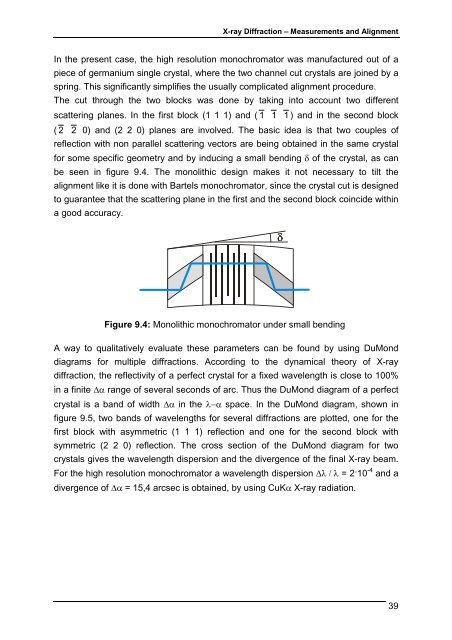Diploma Thesis - Erich Schmid Institute
Diploma Thesis - Erich Schmid Institute
Diploma Thesis - Erich Schmid Institute
You also want an ePaper? Increase the reach of your titles
YUMPU automatically turns print PDFs into web optimized ePapers that Google loves.
X-ray Diffraction – Measurements and Alignment<br />
In the present case, the high resolution monochromator was manufactured out of a<br />
piece of germanium single crystal, where the two channel cut crystals are joined by a<br />
spring. This significantly simplifies the usually complicated alignment procedure.<br />
The cut through the two blocks was done by taking into account two different<br />
scattering planes. In the first block (1 1 1) and ( 1 1 1 ) and in the second block<br />
( 2 2 0) and (2 2 0) planes are involved. The basic idea is that two couples of<br />
reflection with non parallel scattering vectors are being obtained in the same crystal<br />
for some specific geometry and by inducing a small bending δ of the crystal, as can<br />
be seen in figure 9.4. The monolithic design makes it not necessary to tilt the<br />
alignment like it is done with Bartels monochromator, since the crystal cut is designed<br />
to guarantee that the scattering plane in the first and the second block coincide within<br />
a good accuracy.<br />
Figure 9.4: Monolithic monochromator under small bending<br />
The final wavelength, dispersion and divergence are of interest for the measurement.<br />
A way to qualitatively evaluate these parameters can be found by using DuMond<br />
diagrams for multiple diffractions. According to the dynamical theory of X-ray<br />
diffraction, the reflectivity of a perfect crystal for a fixed wavelength is close to 100%<br />
in a finite ∆α range of several seconds of arc. Thus the DuMond diagram of a perfect<br />
crystal is a band of width ∆α in the λ−α space. In the DuMond diagram, shown in<br />
figure 9.5, two bands of wavelengths for several diffractions are plotted, one for the<br />
first block with asymmetric (1 1 1) reflection and one for the second block with<br />
symmetric (2 2 0) reflection. The cross section of the DuMond diagram for two<br />
crystals gives the wavelength dispersion and the divergence of the final X-ray beam.<br />
For the high resolution monochromator a wavelength dispersion ∆λ / λ = 2·10 -4 and a<br />
divergence of ∆α = 15,4 arcsec is obtained, by using CuKα X-ray radiation.<br />
39

















